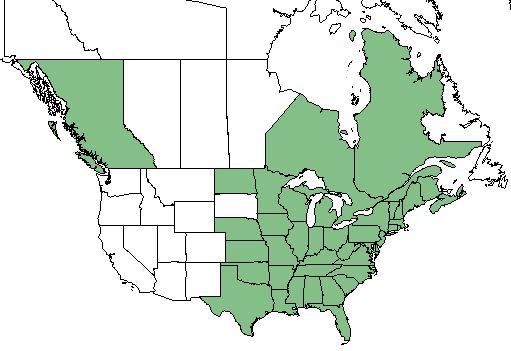Prunus serotina
Common name: wild black cherry [1]
| Prunus serotina | |
|---|---|

| |
| Photo by John Gwaltney hosted at Southeastern Flora.com | |
| Scientific classification | |
| Kingdom: | Plantae |
| Division: | Magnoliophyta - Flowering plants |
| Class: | Magnoliopsida - Dicots |
| Order: | Rosales |
| Family: | Rosaceae |
| Genus: | Prunus |
| Species: | P. serotina |
| Binomial name | |
| Prunus serotina Ehrh. | |

| |
| Natural range of Prunus serotina from USDA NRCS Plants Database. | |
Contents
Taxonomic Notes
Synonyms: Prunus serotina ssp. serotina
Varieties: Prunus speciosa (Koidzumi) Nakai; Prunus spinosa L.
Description
P. serotina is a perennial shrub/tree of the Rosaceae family native to North America and Canada. [2]
Distribution
P. serotina is found in the eastern half of the United States excluding South Dakota, as well as the British Columbia, Ontario, and Quebec regions of Canada. [2]
Ecology
Habitat
P. serotina proliferates in rich coves, bottomlands, northern hardwood forests, and in a wide variety of lower elevation habitats from dry to mesic, and weedy in fencerows. [1] Specimens have been collected from habitats that include wet woods, sandpine woods, longleaf pine wiregrass scrub oak stand, dense swampy forest, open woodland, mesic mixed hardwoods, dry long leaf pine sandhills, hammock, thin stand of planted slash pine, dry mesic harwood forests, slope of narrow ravine, river bank, and semi shaded moist loamy sand in open woodland. [3]
Phenology
P. serotina flowers February-April. [4] This tree sometimes reaches a height of 90 feet and a maximum trunk diameter of 4 feet. The trunk is straight and covered with rough black bark, but the young branches are smooth and reddish. The smooth shining leaves are about 2 to 5 inches long. The long drooping clusters of small white flowers are borne at the ends of the branches, usually during May. The cherries, which ripen about August or September, are round, black, or very dark purple, about the size of a pea, and have a sweet, slightly astringent taste. [5]
Use by animals
P. serotina is a bird-dispersed species. [6] It also serves as the main host plant for the eastern tent caterpillar. [7]
Diseases and parasites
P. serotina is susceptible to the black knot fungus. [7]
Conservation and Management
Cultivation and restoration
Photo Gallery
References and notes
- ↑ 1.0 1.1
- ↑ 2.0 2.1 USDA Plant Database https://plants.usda.gov/core/profile?symbol=PRSES
- ↑ URL: http://herbarium.bio.fsu.edu. Last accessed: June 2018. Collectors: Loran C. Anderson, R.K. Godfrey, O. Lakela, Frank Almeda, Richar Mitchell, Robert lazor, L.R. FOx, J. Harrison, R. Garren, Patricia Elliot, Gary Knight, Gwynn W. Ramsey, H. Larry E. Stripling, Mr. H.A. Davis, Mrs. H.A. Davis, S.W. Leonard, Wilson Baker, Alush Shilom Ton, R. Komarek, Ed Keppner, Lisa Keppner, K. MacClendon, T. MacClendon, Geo. Wilder, Albert B. Pittman, Herrick H.K. Brown, R. Kral, Dorothy Cladin, Pete Mazzeo, lizabeth Gibson, Dick Harlow, Angus Gholson, B. Boothe, A. Sagastegui, J. Mestacere, M. Diestra. States and counties: Florida (Franklin, Washington, Jefferson, Leon, Jackson, Hillsborough, Union, Marion, Duval, Liberty, Madison, Walton, Gadsden, Wakulla, Bay, Calhoun, Holmes, Volusia, Putnam, St. John, Escambia, Santa Rosa) Georgia (Thomas, Grady,Marion, Rockdale, Baker) South Carolina (Lexington) Virgin Islands.
- ↑ PanFlora Author: Gil Nelson URL: http://www.gilnelson.com/PanFlora/ Date Accessed: 5/24/18
- ↑ Sievers, A. F. (1930). American medicinal plants of commercial importance. Washington, USDA.
- ↑ Leck, M. A. and C. F. Leck (1998). "A ten-year seed bank study of old field succession in central New Jersey." The Journal of the Torrey Botanical Society 125(1): 11-32.
- ↑ 7.0 7.1 USDA Forest Service (1989). Insects and diseases of trees in the South. USDA Forest Service, Atlanta, GA. Protection Report R8-PR 16. F. S. S. Region: 98.